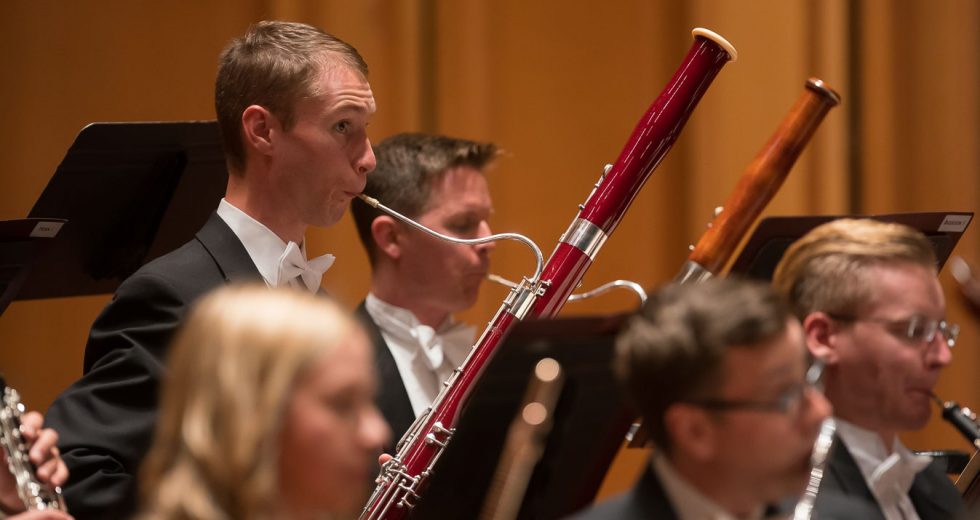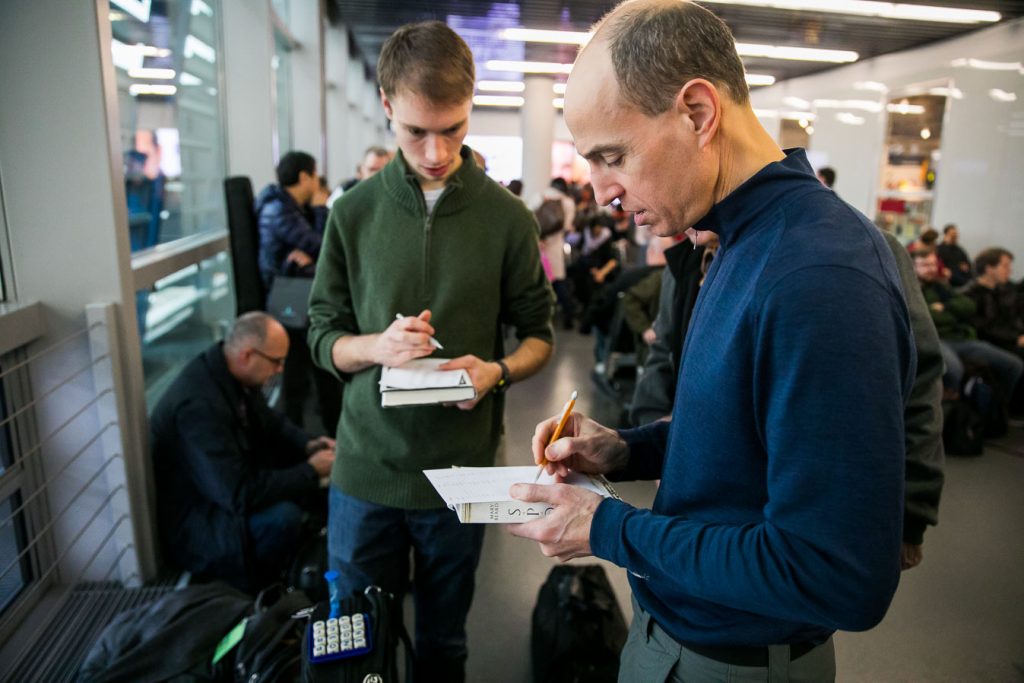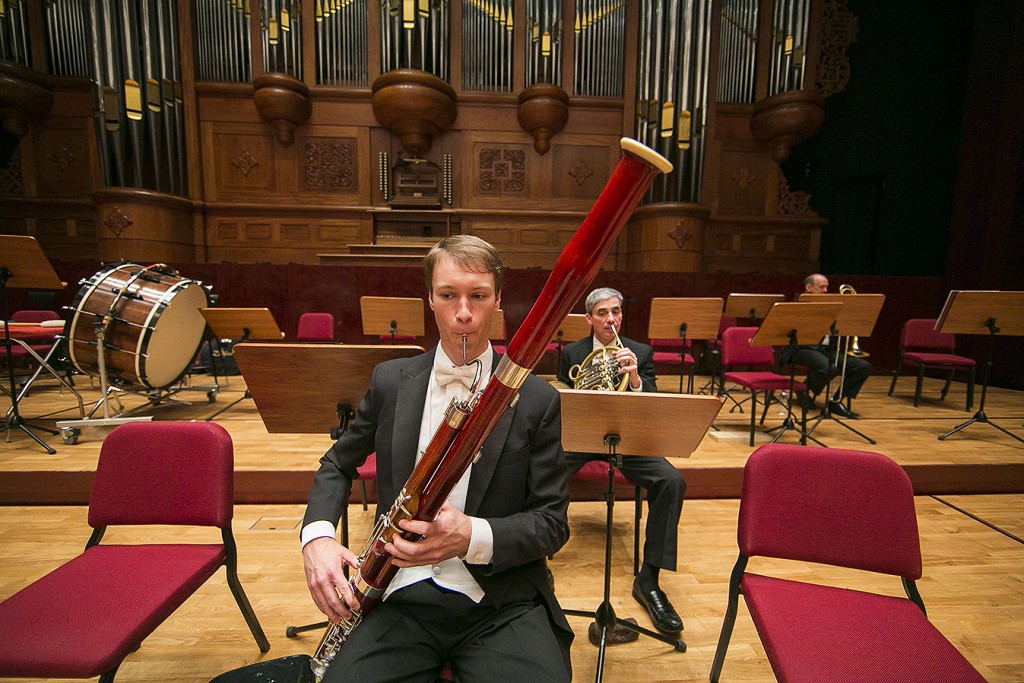
At 11, Keith Buncke heard a recording of Bach’s Brandenburg Concerto No. 1, with prominent parts for the oboe and bassoon, and he was immediately struck by the sound of the double-reed instruments. In those early internet days, he looked up the instruments in the encyclopedia, and he gravitated toward the bassoon in part because the player pictured appeared more comfortable and relaxed. Buncke also liked the bassoon’s unusual look and its warm, baritone sound. He asked his mother, who had started him on the piano four years earlier, and the cello soon thereafter, if he could take bassoon lessons, and she agreed. “Luckily, she found me a teacher and got me set up with an instrument,” he said. “I really loved it right away. I was really motivated to practice.”
Eleven years later, Buncke was appointed as the principal bassoonist of the Chicago Symphony Orchestra, taking over the position in July 2015. He was confident he would like his new post, but it has far exceeded his expectations. “It sounds funny,” he said, “but I would say that the surprise would be just how much I enjoy the job. Just how much I really love working on the repertoire, and bringing it to the ensemble. It’s this beautiful, big puzzle and everyone brings their own puzzle piece and makes sure it is really good. And it all fits together and makes this big picture, and I love being part of that.”
CSO audiences will get their first up-close look at Buncke on Jan. 18 and 20 when he makes his solo debut, under guest conductor Rafael Payare, in Mozart’s Bassoon Concerto (1774) — the most frequently performed such work for the instrument. Buncke acknowledges that he has performed concertos only a few times and has tackled this piece just once before, performing it with the Verde Valley Sinfonietta in Sedona, Ariz., when he was still a student.

Keith Buncke, CSO principal bassoon, and viola Lawrence Neuman play a little Boggle as they wait to board a flight while on a CSO tour. | © Todd Rosenberg Photography 2017
“As it the case for most bassoonists, I would say that my main focus has been orchestral and chamber music — more ensemble-focused,” he said. “One of the reasons I’m looking forward to performing this concerto is that it is something very different than what I do 99 percent of the time. So it’s an opportunity for growth and exploration.” Usually, he said, the bassoon has a “chameleon-like” presence in the orchestra, playing bass and harmonic lines, contributing inner voices and only occasionally grabbing the spotlight with a solo. “With a concerto, you always have the solo voice, so you don’t have to be quite as flexible in a way, and you have the freedom to sing out.”
Buncke, who’s now 24, also is excited because he is writing his own cadenzas. The work has a long such solo in the first movement, a shorter one in the second movement and a kind of lead-in or mini-cadenza in the third movement. “That’s one way to put your personal stamp on a piece in a way,” he said, “and bring something new or individual to it.”
Born in California’s suburban Orange County, Buncke moved with his family when he was 9 to Lake Oswego, a suburb of Portland, Ore. For a while, Buncke was playing all three of his instruments and even trying his hand at composition, but by age 15, he was focused exclusively on the bassoon.
During his sophomore year of high school, he largely exhausted the local musical opportunities, playing in the Portland Youth Philharmonic and participating in as many area competitions as he could. So with the encouragement of an Oregon Symphony Orchestra bassoonist and his Youth Philharmonic music director, he spent his last two years of high school at Michigan’s Interlochen Arts Academy, a prestigious arts-focused boarding school.
Shortly before he graduated in May 2011, Buncke was featured on “From the Top,” the National Public Radio program that showcases young classical musicians. He performed with the show’s host, pianist Christopher O’Riley, and talked about his experiences as a bassoonist. He recalls being more nervous about the speaking than the playing. “It’s a unique challenge in that you do an interview in conjunction with your performance,” he said. “Usually, I don’t talk right before performing.”

Keith Buncke and Dan Gingrich, assistant principal horn, warm up before a concert on the CSO’s 2016 tour of Asia. | © Todd Rosenberg Photography
By the time he went to Interlochen, he knew he was committed to the bassoon. “That’s when I got really serious about it and starting practicing a lot — three or four hours a day,” he said. “There wasn’t anything else that I considered doing or could imagine myself doing.”
He went on to the elite Curtis Institute of Music in Philadelphia, leaving three years later with a performance diploma. In fall 2013, two other bassoon students planned to audition for the vacant principal bassoon position at the Atlanta Symphony Orchestra, and he decided to join them. “Around the beginning of my third year at Curtis, [I thought] I was ready to start taking orchestra auditions,” he said. “It wasn’t necessarily a matter of needing a job right then, but due to the scarcity of good orchestral jobs like that, it seemed like a good [idea].”
Buncke was one of two applicants chosen to return in the spring for trials with the orchestra, and he ultimately won the job. “In that audition process in the fall, I was pretty surprised,” he said. “I felt that I played pretty well, but I wasn’t expecting anything. When I kept getting advanced from the preliminary round to the semi-finals to the final round and then getting the trial — every round I was a little bit surprised. I was not necessarily confident that I was the best one or that I played the best audition.”
Because of a two-month labor dispute, however, the Atlanta Symphony’s 2014 season did not begin until November. In the meantime, Buncke auditioned for the Chicago Symphony’s principal bassoon position, which had become available. He traveled to Chicago for the preliminary round in October and was invited back for the finals in January 2015, ultimately emerging as the winner.
“Principal bassoonist of the Chicago Symphony — that kind of job opening for that level of orchestra comes around maybe every 10 years or something,” Buncke said. “So it was a really rare opportunity, and I couldn’t pass it up. Atlanta is a great orchestra, and they have a great tradition there as well. But you can’t really beat the Chicago Symphony.”
Moving to a new orchestra requires considerable adjustments for anyone. But as Buncke is quick to acknowledge, the task was more challenging for him because he had played only a few months in Atlanta and had little professional orchestra experience. “Orchestral playing in general, I had to learn a lot, especially in my first season,” he said. “There was a big learning curve there. There is so much you can only learn from experience.”
He had to learn about blending and interacting with a room full of other musicians, and he had to refine his playing to match the level of the CSO’s. “Since being in Chicago, I’ve learned to open up the sound and project in a huge hall like Orchestra Hall and just to expand the dynamic range and the color palette,” he said. In addition, he had to become comfortable with all the roles that the bassoon plays in the orchestra. “Ninety-nine percent of what you play is background stuff,” he said. “It’s not really the melody. A lot of these orchestral excerpts that you learn, that you play for auditions, are these bassoon solos that only make up a small fraction of the piece. A lot of it is learning how to play the other things with consistency and confidence.”
What has helped Buncke along the way is the support that he has received from the CSO. “I never sensed any kind of ageism or doubting,” he said. “It was a steep learning curve, and I was able to learn and adapt quickly. I couldn’t ask for nicer colleagues around me.”
TOP: Keith Buncke in performance with the Chicago Symphony Orchestra. | ©Todd Rosenberg Photography